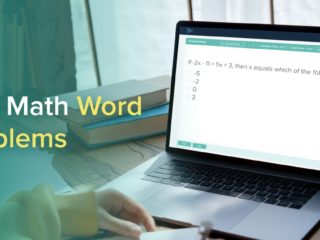| Getting your Trinity Audio player ready... |
On the SAT, knowledge of percentage concepts and calculations is paramount. Not only will you encounter SAT percent questions, but you’ll also see them nearly every day in real life. It’s a two-fer! So, you can certainly benefit from knowing the ins and outs of percentage questions.
Quick Answer: SAT percent problems test your ability to calculate percentage increases, decreases, and comparisons using simple formulas. The most common SAT questions include percent change, discounts, interest, and calculating percents from frequency tables. Keep reading for step-by-step strategies, examples with detailed solutions, and SAT percent tips and tricks to boost your SAT math score.
Here are the topics we’ll cover:
- An Overview of SAT Math Topics
- Percent to Decimal Conversion
- SAT Percent Examples with Solutions
- Key Takeaways
- Frequently Asked Questions (FAQ)
- What’s Next?
Before we look at some practice questions, let’s take a look at the math topics that are tested on the SAT.
An Overview of SAT Math Topics
There are a total of 44 questions in the SAT Math section, which is divided into 2 “modules,” and you are allowed to use a calculator for both modules.
The modules follow what is called “adaptive scoring,” which means that the difficulty of Math module 2 depends on how well you perform on Math module 1. Thus, module 2 could be harder, easier, or about the same difficulty as module 1, depending on how well you did on the first module.
KEY FACT:
There are a total of 44 questions in the SAT Math section.
There are 4 major categories of SAT Math questions. Let’s look at each category and the math topics covered in each:
- Algebra:
- linear equations
- linear functions
- linear inequalities
- systems of linear equations
- Advanced Math:
- nonlinear equations
- systems of nonlinear equations
- nonlinear functions (e.g., quadratic functions)
- Problem Solving and Data Analysis (PSDA):
- ratios
- proportions
- percentages
- data distributions
- measures of center and spread
- data interpretation
- scatterplots
- probability
- statistical significance
- margin of error
- evaluating statistical claims
- Geometry and Trigonometry:
- area
- volume
- lines
- angles
- triangles
- circles
- right triangle trigonometry
Questions from Algebra and Advanced Math together make up about 70% of SAT math questions, at about 35% each. Problem Solving and Data Analysis questions and Geometry and Trigonometry questions make up the other 30%, at about 15% for each of those 2 categories.
As we can see, percentage questions fall under the category of Problem Solving and Data Analysis (PSDA). You can expect to see 2–3 questions about percentages on the SAT.
KEY FACT:
You can expect to see 2–3 percentage questions in the SAT Math section.
Before we look at the practice problems, let’s review a basic arithmetic operation that is necessary for essentially every percentage question on the SAT: percent to decimal conversion and the reverse.
Percent to Decimal Conversion
Here are the 2 rules you should memorize:
- To convert a percent to a decimal, move the decimal point 2 places to the left and delete the percent symbol.
Example: 25.6% becomes 0.256 in decimal form. - To convert a decimal number to a percent, move the decimal point 2 places to the right and add a percent sign.
Example: 0.078 becomes 7.8% as a percent.
TTP PRO TIP:
Memorize the rules for converting from percent to decimal and from decimal to percent.
SAT Percent Examples with Solutions
Percentage questions range from SAT “percent of a number” questions to advanced ones involving geometric shapes or compound interest.
Let’s look at some sample questions of representative percentage questions.
Example 1: “Percent of”
12% of 50 is ⅛ of what number?
- 3/4
- 8
- 48
- 80
Solution:
This is a 2-part question. First, let’s calculate 12% of 50, recalling that the word “of” means “multiply.”
To convert 12% to a decimal number, move the decimal point 2 places to the left. Thus 12% = 0.12.
(0.12) x 50 = 6
We can solve the second part of the question by restating it as “6 is 1/8 of what number?” Recall that the word “is” generally indicates an equal sign, and the word “of” means “multiply.”
Let the number = N
6 = 1/8 x N
Multiplying both sides of the equation by 8 gives us:
48 = N
Answer: C
KEY FACT:
In percentage problems, the word “of” means “multiply,” and the word “is” means “equals.”
Example 2: Sales Tax
Roma bought a laptop for $375. The sales tax rate in her city is 4.2%. What was the total cost of the laptop, including sales tax?
- $379.20
- $390.75
- $417.00
- $532.50
Solution:
Sales tax is an amount of money added to the cost of an item. We can use the general formula:
total cost = item cost + sales tax
To determine the sales tax, we multiply the item cost by the sales tax rate expressed as a decimal:
sales tax = item cost x sales tax rate
Combining these 2 formulas, we have:
total cost = item cost + (item cost)(sales tax rate)
Let’s fill the known information into the formula.
total cost = 375 + (375)(0.042)
total cost = 375 + 15.75
total cost = $390.75
Answer: B
KEY FACT:
The sales tax formula is: sales tax = item cost x sales tax rate.
Example 3: Percent Decrease
After the price of a handbag was reduced by 36%, its new price was $57.60. What was the original price of the handbag, rounded to the nearest dollar?
- $78
- $90
- $94
- $95
Solution:
We can use the “percent decrease” formula to calculate the original price.
First, we let X = the original price.
final price = (original price) (100% – percent decrease)
57.60 = X (100% – 36%)
57.60 = X (64%)
57.60 = 0.64X
90 = X
Answer: B
In addition to percent decrease questions, you may encounter SAT problems that ask about a percent increase. A similar formula is used for the latter, but because we’re dealing with a percent increase, we add instead of subtract.
Here is the percent increase formula:
final price = (original price) (100% + percent increase)
TTP PRO TIP:
Use the percent increase or percent decrease formulas when prices change by a percentage.
Example 4: Percent Change
In 2015, a small town’s population was 3,412. Five years later, the population had grown to 4,190. To the nearest percent, what was the percent increase in the town’s population in this five-year period?
- 23
- 29
- 34
- 55
Solution:
This is an easy problem to solve if you recall the SAT “percent change” formula:
percent change = (new – old) / old x 100%
The new population is 4,190, and the old population is 3,412. So, we substitute these values into the percent change formula:
percent change = (4,190 – 3,412) / 3,412 x 100%
percent change = 778 / 3,412 x 100%
percent change = 0.228 x 100%
percent change = 22.8%
Answer: A
TTP PRO TIP:
You can use the percent change formula, (new – old) / old x 100%, for percent increase or percent decrease questions.
Example 5: Successive Percent Markdown
A pair of socks selling for $15 was marked down by 10%. A week later, its reduced price was marked down by an additional 20%. What was the final selling price of the pair of socks?
- $9.70
- $10.00
- $10.50
- $10.80
Solution:
The most straightforward way to solve this problem is to perform each price reduction individually to find the final selling price.
first markdown amount: 15 x 0.10 = 1.50
The first markdown is $1.50, so the resulting selling price is $15.00 – $1.50 = $13.50.
Now, we further reduce that marked-down price of $13.50 by 20%:
second markdown amount: 13.50 x 0.20 = 2.70
The second markdown of $2.70 is subtracted from the reduced selling price, so we have:
13.50 – 2.70 = 10.80
The final selling price of the pair of socks is $10.80.
Alternate Solution:
A much faster and less error-prone technique to answer SAT discounts involves the technique of successive discounts. Here’s how it works:
When the first reduction of 10% is taken, the socks will sell for 90% of the original price. Thus, we could multiply $15.00 by 0.90 to get the reduced selling price after the first discount is applied.
Now note that the next discount of 20% would result in the final selling price being 80% of the reduced price. We would thus multiply that reduced selling price by 0.80 to get the final selling price.
Thus, to get the reduced selling price with ONLY 1 calculation (instead of 4), we could perform the following:
final selling price = 15.00 x 0.90 x 0.80 = $10.80
Using this technique has 2 advantages: (1) It reduces the number of computations from 4 to 1, saving you time. (2) It reduces the probability of your making a careless mistake.
Answer: D
TTP PRO TIP:
The successive discount formula technique can save you time and errors.
Example 6: Simple Interest
Mark borrows $600 from the bank, which charges him 7% simple interest per year. He pays the bank in full after 3 years. How much does he pay the bank?
Solution:
Note that there are no answer choices for this question. It is a fill-in-the-blank question, officially known as a “student-produced response” (SPR) question. SPR questions constitute about 25% of the SAT math questions.
This problem can be solved easily if you recall the formula for simple interest:
I = P x r x t
In this question:
P = principal = $600
r = annual interest rate = 0.07
t = time, in years = 3
I = P x r x t
I = 600 x 0.07 x 3
I = 126
The interest he paid was $126.00.
Since he paid the bank in full, he paid a total of 600 + 126 = $726 to the bank.
Note that for SPR answers, you don’t include the dollar sign. The College Board has specific instructions for entering your SPR into the answer box, which you can find on page 7 of the Bluebook Test Directions pamphlet.
Answer: 726
KEY FACT:
The simple interest formula is I = P x r x t.
Example 7: Percents in Data Interpretation Charts
In a large corporation, 136 individuals were randomly selected. Their answers to two questions — their marital status and their living situation — were recorded in the frequency table below.
What percent of renters are single? (Round your answer to the nearest percent.)
- 38%
- 46%
- 65%
- 80%
Solution:
The question directs our attention to renters, so we consider only the 79 individuals who are renters. Of those 79 renters, 51 are single.
51/79 ≅ 0.6456 ≅ 65%
Answer: C
TTP PRO TIP:
Know how to calculate percents from data in frequency tables.
Key Takeaways
- Of the 44 math questions on the SAT, you can expect 2–3 questions about percentages.
- The 7 types of percent questions you may encounter on the SAT include:
- “percent of”
- sales tax
- percent decrease
- percent change
- successive percent markdown
- simple interest
- percents in data interpretation charts
- Here are some tips we covered concerning percent problems:
- Memorize the rules for converting from percent to decimal and from decimal to percent.
- In percentage problems, the word “of” means “multiply,” and the word “is” means “equals.”
- Use the percent increase or percent decrease formulas when prices change by a percentage.
- The successive discount formula technique can save you time and errors.
- Know how to calculate percents from data in frequency tables.
- These are some of the useful formulas we can use for solving percent problems:
- sales tax = item cost x sales tax rate.
- percent change: (new – old) / old x 100%
- simple interest: is I = P x r x t
Frequently Asked Questions (FAQ)
How do you solve SAT percent problems quickly?
First, realize that you must concentrate on accuracy before speed. There is no sense in answering 10 SAT questions in 10 minutes only to realize after you finish that you’ve missed half of them! So, the first tip for getting faster is to go slower, concentrating on getting every question correct. Then, with practice, your speed will develop. Your SAT math percent practice sessions will be more productive if you use this strategy.
Memorizing the important SAT percent formulas will also give you a leg up on speed. If you know a formula, you won’t waste valuable time racking your brain to come up with it. Your SAT math percent practice sessions will be more effective and productive.
What formulas do I need for SAT percent problems?
The math reference sheet provided to you on test day does not provide any percent formulas, so you will need to memorize the ones you need. In this article, we have provided the most important ones:
- percent to decimal conversion
- decimal to percent conversion
- “percent of”
- sales tax
- percent decrease/increase
- percent change
- successive percent increase/decrease
- simple interest
At a minimum, you should know these.
How many percent questions are on the SAT?
It’s impossible to specify the exact number of percent questions you will encounter on any particular test, but you can expect to see 2–3 percent questions on average.
Are percent problems considered easy or hard on the SAT?
Are there hard SAT percent problems? Not really. Generally, students consider percent questions to be relatively easy. Many math questions cover advanced algebra or trigonometry, which most students would say are much more difficult than percent problems. Thus, it is important that you master percent questions, as they will allow you to increase your score relatively easily.
What’s the best way to practice SAT percent problems?
Find a solid SAT resource, whether it’s a study book or an online course. Then, answer every SAT percent question that your resource offers, and practice until you get every question correct within 1 minute and 35 seconds, which is the average time allotted for each SAT math question. Remember to strive first for accuracy and then for pace.
If you’re looking for a great SAT Math resource, you can try out the Target Test Prep online course free for 5 days!
What’s Next?
Knowing how to solve SAT percent questions is just one of many skills you will need to be successful on your exam. For more practice, take a look at a great sampling of digital SAT math questions from all math categories.
If you want to challenge yourself with tough questions, you can get some fantastic practice with our selection of hard SAT math questions.
To see more formulas that you need to know for test day, check out our article about SAT math formulas.
Good luck!



